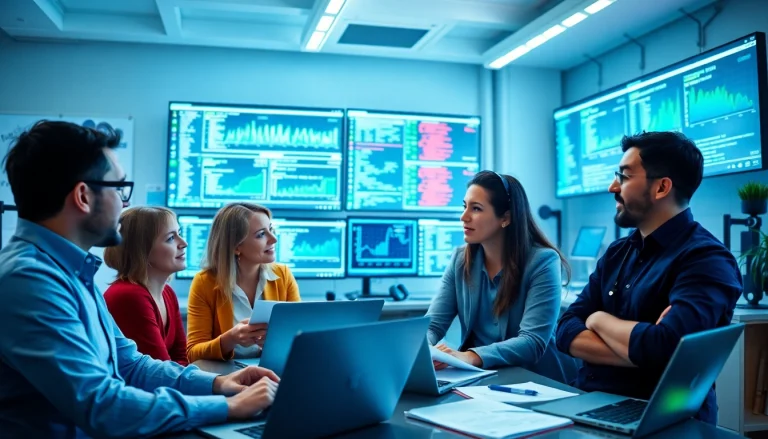
Understanding the Basics of 3D Model Visualizations
What are 3D Model Visualizations?
3D model visualizations are digital representations of objects created using three-dimensional (3D) design software. These visualizations can range from simple geometric shapes to complex interactable models used in various applications, including architecture, gaming, and product design. Unlike traditional 2D images, 3D visualizations allow viewers to see depth and dimension, making them invaluable for conveying information in a more engaging and realistic manner. By utilizing advanced rendering techniques, these models can simulate how light interacts with surfaces, creating highly detailed and life-like representations. For a deeper dive into the role of 3D Model Visualizations, it is essential to explore the impact they have across industries.
Importance of 3D Visualizations in Various Industries
The significance of 3D model visualizations extends far beyond aesthetics; they play a crucial role in numerous industries:
- Architecture and Construction: Architects use 3D visualizations to create realistic models of their designs, allowing clients to better understand the final structure before construction begins. This fosters better communication and fewer misunderstandings.
- Healthcare: In medicine, 3D visualizations are used to create detailed models of organs for surgical planning, helping surgeons visualize complex procedures and potentially reducing risks during operation.
- Product Design: Designers use 3D models to prototype products, allowing for easy alterations before physical prototypes are built. This reduces costs and speeds up the time from concept to market.
- Gaming and Entertainment: In the gaming industry, 3D visualizations bring characters and worlds to life, creating immersive experiences for players through detailed environments and realistic movements.
Key Terms in 3D Visualization
To fully grasp the concept of 3D visualizations, it is beneficial to understand key terminology associated with this field:
- Rendering: The process of generating a 2D image from a 3D model by simulating light, shading, and texture.
- Modeling: The creation of 3D objects using vertices, edges, and faces to form shapes.
- Texture Mapping: The technique of applying images to a 3D model’s surface to give it detail and realism.
- Animations: The process of creating movement in a 3D model, often used in presentations and applications.
Essential Tools for Creating 3D Model Visualizations
Overview of Software Options Available
Numerous software applications are available for creating 3D model visualizations, each with unique features tailored to different user needs. Some of the leading software options include:
- Autodesk Maya: A professional-grade software that offers robust modeling, animation, and rendering tools, widely used in film and game development.
- Blender: An open-source software that provides a comprehensive suite for 3D modeling, animation, simulation, and rendering.
- SketchUp: Known for its user-friendly interface and simplicity, SketchUp is ideal for architectural designs and quick prototyping.
- 3ds Max: A powerful tool favored in the video game industry and by architects, known for its excellent rendering capabilities and modeling tools.
Hardware Considerations for Optimal Performance
Creating detailed 3D model visualizations requires powerful hardware to handle the demands of rendering and processing. Key hardware components include:
- Graphics Card: A high-performance GPU is essential for rapid rendering and smoother manipulation of 3D models.
- Processor: A multi-core CPU will enhance rendering speed and improve overall performance during complex tasks.
- RAM: Sufficient RAM is crucial, as 3D applications can be memory-intensive, especially when handling multiple models and textures.
- Storage: SSDs provide faster read/write speeds, significantly improving load times and workflow efficiency.
Integration with Other Design Tools
Effective 3D visualizations often involve a combination of different software tools. For example, designers might use Adobe Photoshop for texture editing, AutoCAD for architectural layouts, and a dedicated 3D visualization software for rendering. Integrating these tools allows for a more seamless design process:
- File Formats: Understanding the compatibility of file formats across different software is essential to maintain the quality of the designs.
- Collaboration Tools: Many 3D visualization tools now offer cloud-based solutions to facilitate collaboration among team members and clients.
- Plugins and Extensions: Numerous software have plugins to enhance functionality, making it easier to incorporate advanced rendering techniques or specific industry needs.
Best Practices for Effective 3D Model Visualizations
Choosing the Right Color and Lighting Techniques
Color and lighting are fundamental elements that significantly impact the effectiveness of a 3D visualization:
- Color Theory: Understanding the relationships between colors can help create visually appealing designs. Using complementary colors can enhance contrast, while analogous colors provide harmony.
- Lighting Techniques: Implementing three-point lighting (key light, fill light, and back light) can add depth and realism to a scene.
- Environment Effects: Consider using ambient occlusion and global illumination to create realistic lighting that mimics real-world conditions.
Rendering Techniques for Realism
Rendering is the final step in creating a 3D model visualization, and applying advanced rendering techniques can elevate the quality of the final output:
- Ray Tracing: A rendering technique that simulates the behavior of light to produce real-time, high-quality visuals.
- Physically Based Rendering (PBR): A method that uses mathematical models to simulate all aspects of light transport, providing a more realistic appearance for materials and textures.
- Post-Processing: After rendering, additional adjustments through post-processing can enhance the final image quality, including color correction and depth of field effects.
Common Mistakes to Avoid
While creating 3D model visualizations, several common pitfalls can compromise quality:
- Lack of Planning: Insufficient pre-visualization to outline the desired outcome can lead to scope creep and inefficient use of resources.
- Poor File Management: Not organizing files and assets appropriately can lead to chaos when updating or collaborating on projects.
- Ignoring Feedback: Failing to seek feedback from peers or clients might result in overlooking crucial aspects that could improve the visualization’s effectiveness.
Industry Applications of 3D Model Visualizations
Architecture and Construction
In the architecture and construction sectors, 3D model visualizations stand as indispensable tools. They transform complex architectural concepts into tangible representations:
- Client Presentations: Architects can present 3D visualizations to clients, allowing them to visualize the final outcome effectively before laying the first brick.
- Regulatory Approvals: Detailed visualizations can ease the process of obtaining approvals from zoning boards or other regulatory bodies by providing a clear depiction of the project.
- Collaboration Among Stakeholders: 3D models enable various stakeholders, from engineers to contractors, to collaborate effectively, ensuring everyone is on the same page.
Product Design and Marketing
3D visualizations play a transformative role in product design and marketing by allowing for comprehensive showcases of products:
- Prototyping: Designers can create and iterate on product prototypes quickly, allowing for rapid testing and modification before moving to physical manufacturing.
- Marketing Campaigns: Businesses use 3D visualizations in advertisements, allowing potential customers to experience their products from every angle, boosting engagement and interest.
- Virtual Showrooms: E-commerce platforms utilize 3D model visualizations to create virtual showrooms where customers can explore products interactively.
Gaming and Virtual Reality
In the realms of gaming and virtual reality (VR), 3D model visualizations are central to creating immersive experiences:
- Character Design: Game developers meticulously design 3D characters using visualizations that allow for detailed animation and interaction.
- Environment Creation: Complex game worlds are constructed using 3D visualizations, creating interactive environments that enhance gameplay.
- VR Experiences: 3D visualizations play a critical role in developing virtual reality applications, allowing users to engage with digital environments in lifelike ways.
Measuring Success: Metrics for Evaluating 3D Visualizations
Feedback Mechanisms from Users
Evaluating the effectiveness of 3D model visualizations is crucial in ensuring they meet the intended purpose. Some key metrics to consider are:
- User Engagement: Tracking engagement metrics, such as the time spent on a visualization or interaction rates, provides insight into user interest and usability.
- Client Feedback: Gathering feedback through surveys or direct interviews can help identify areas for improvement in the visualization.
- A/B Testing: Testing variations of visualizations with different user groups can determine which designs resonate more effectively.
Impact on Sales and User Engagement
One of the most compelling metrics for 3D visualizations is their direct impact on sales and user engagement:
- Conversion Rates: Analyzing how 3D visualizations affect conversion rates can showcase their effectiveness in persuading customers to make purchases.
- Customer Retention: Engaging visualizations can enhance user experience, leading to higher customer retention rates.
- User Feedback and Reviews: Monitoring user reviews can provide qualitative data on how 3D visualizations influence customer opinions and brand perception.
Future Trends in 3D Model Visualization Metrics
The landscape of 3D model visualizations is continually evolving, influenced by advancements in technology and user expectations. Future trends include:
- AI-Powered Analytics: The development of artificial intelligence tools to measure user interaction with 3D visualizations will provide more accurate and actionable insights.
- Real-Time Feedback: As engagement tools become more sophisticated, businesses will increasingly rely on real-time feedback mechanisms to adapt visuals quickly.
- Integration with Big Data: Leveraging big data analytics will enable organizations to derive more profound insights into user behavior and preferences, tailoring 3D visualizations accordingly.






